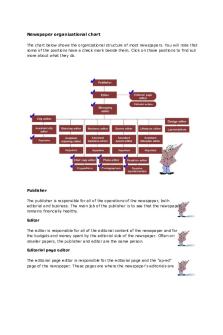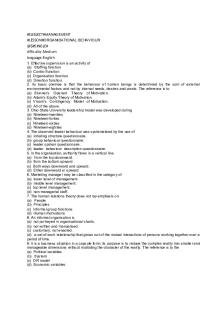6.) Organisational Decision-Making and Learning - The Carnegie School PDF

| Title | 6.) Organisational Decision-Making and Learning - The Carnegie School |
|---|---|
| Course | Organizational Theory |
| Institution | Universität Mannheim |
| Pages | 5 |
| File Size | 250.2 KB |
| File Type | |
| Total Downloads | 62 |
| Total Views | 146 |
Summary
Download 6.) Organisational Decision-Making and Learning - The Carnegie School PDF
Description
03/05/16
6.) Organisational Decision-Making and Learning The Carnegie School Outline I.
The Carnegie School of Organisational Theory: Uncertainty & Ambiguity
II. The Complete Cycle of Choice
I. The Carnegie School of Organisational Theory Decision-Making in a Rational Model (H.A. Simon) Standard model = intentional, future-oriented, leading to optimal choices • Assumes accurate knowledge about all alternatives • Certainty = consequences of all alternatives are known • Uncertainty into risk = probability distribution of consequences of all alternatives can be estimated • Consistent ordering of preferences when comparing alternatives and their consequences = utility function maximizes preferred choice • Decision rules to select among alternatives and their consequences Limits of Ambiguity: Uncertainty & Ambiguity Organisations and members may intend to be rational, but often act on bounded rationality: - Incomplete/incorrect information without awareness about alternatives - Information overload and limits to human cognitive capacities
- Rarely a well-defined preference function to compare alternatives and their consequences Preferences discovered through action (not actions guided by extant preferences)
- Coordinate inconsistent and conflicting goals through trial and error
“Humans… behave rationally, if at all, only relative to some set of ‘given’ characteristics of the situation” (March & Simon, Organizations, p.172) Ambiguity in Organisations (1) Ambiguity of intention: organizations often have ill-defined and inconsistent goals and preferences. (2) Ambiguity of understanding: difficult for organizations to interpret what happens in their environment, and to recognize the causal relations between organizational actions and consequences. !1
03/05/16 Ambiguity in Organisations (3) Ambiguity of history: path-dependence of organizations is important, but the past is not easily interpreted. (4) Ambiguity of organization: members of organizations come and go; their participation in decision-making is uncertain and changing. Consequences for Organisational Choices Bounded/limited rationality = • Individuals are intendedly rational (decision makers try to be rational), but are constrained by limited cognitive capabilities and incomplete information • Search for a solution that is “good enough” Decisions in organisations often just “happen” Major question: How do organizations manage to achieve their goals as a collectivity when they are composed of individual decision makers who face bounded rationality, an uncertain organizational environment, and a limited capacity to process information and perform tasks?
II. The Complete Cycle of Choice Process of Organisational Decision
(1) Choice opportunity (identify problem and search for satisfactory solution) (2) How decisions are made (situation and attention rules) (3) Who makes decisions and when (Access structures and organised anarchy) (4) The organisational environment (ecology such as competition, exploitations vs. exploration) (1) Choice opportunity Feedback from organisational environment, recognition of a problem in the organisational environment (e.g. problems with the exam amount, amount of English classes, etc. in the Sociology course at the University of Mannheim)
!2
03/05/16 (1) Choice opportunity The main decision problem is the search for a satisfactory solution (2) How decisions are made/How decisions happen Individual decision maker (e.g. Director of Undergrad Program in Mannheim) “Definition of the situation” = simplified, approximate model of the real situation, which, like a good theory, neglects evidence and is selective in allocating attention, while limiting the choice situation to things that matter/are appropriate) Search for satisfactory solution, not optimal solution = logic of appropriateness Decision making in organizations is rule-based action Time and energy resources are scarce: • Reliance on existing routines • Expectation to act according to rules and conventions, even if it may not always be in their best interest • Routines/rules help in allocating our scarce attention to problems that matter and are from the stock of knowledge in organisations (from previous experience) • Considering alternatives ends up in opportunity costs (3) Who makes the decisions and when? Organisations avoid to correctly predict the future (= outcomes of organisation actions) and also try to avoid uncertainty and reduce complexity of decisionmaking: - Breaking down of complex problems into smaller ones that are delegated using standard operating procedures/routines - Preference for short-term solutions, rather than unpredictable long-term strategies Collective decision making works like a computer program with sequences of small routines to solve more complex problems Multiple members/decision makers: • Conflicting interests • Conventions (“good conduct”) help reduce conflicts and form coalitions, but are often ritualistic and look like myths that have lost substantive meaning • Reduction of complexity into smaller steps also reduces said conflict over broader goals • Who gets to decide what and when?
!3
03/05/16 (3) Who makes the decisions and when? (1) Attention structures = What needs attention? (a) Unsegmented structures: anyone can decide anything; any problems and known solutions may be paired. (b) Specialized structures: selected members of organization attend to selected problems only (solutions are appropriate for selected problems, but not all problems) (c) Hierarchical structures: attention by rank.
- Low ranking members attend to low
-
ranking problems ➤ solutions appropriate only for low ranking problems High ranking members attend to any problem ➤ appropriate for any problem.
(2) Access/decision structures = Selection of who decides? (a) Unsegmented participation: anyone can participate in decision (b) Specialized participation: each member of organization participates in a single decision; each choice has single decision maker. (c) Hierarchical participation: participation by rank. Important decision makers participate in many choices. But important choices are made only by important decision makers. etc.
Garbage Can Decision Process: • Organised Anarchy = Loose coupling of individual action and collective organizational action • Confluence of fleeting (a) choice opportunities, (b) problems, (c) solutions, and (d) decision makers who participate. - Temporal order and proximity - Loose coupling of decisions and decision-makers in networks, not coherent hierarchies • Organised anarchies are organizations characterized by (1) problematic preferences, (2) unclear technology, and (3) fluid participation.
!4
03/05/16 (4) Relation to Environment Stock of knowledge helps organisations cope with anarchy: • Organisational Code: Known solutions from previous experience that look for problems (codified in roles, routines and rules, conventions, symbols, standard operating procedures) What if these solutions don’t work? Learning from environment? • Ecology of the organisations means competition for scarce resources, but also sources of new knowledge • Two important choices: Exploration vs. Exploitation (1) Exploration = • New possibilities, returns to experimentation • Are not immediate (takes time to learn new skills) and uncertain
(2) Exploitation = • Old certainties (e.g. learning from the organisational code) • Immediate and increasing returns on investment in competence • Increasing reliability
Need for balance: • Little benefit from too much exploration without exploitation of new knowledge • Too much exploitation of known solutions without enough exploration leads to lack of adaptability (organization becomes trapped in suboptimal stable equilibria) Consequences for organisational learning: • More exploitation is effective long-term because it improves reliability of solutions to known problems • But learning from organisational code can be destructive in the long-run - Only small increment of average intelligence in organisational members (People learn from code before code can learn from them = variance of knowledge is not improved) - Yet, this variance of knowledge/technologies is central in a competitive organisational environment
!5...
Similar Free PDFs

Case Study Ethics Decisionmaking
- 3 Pages

Etapas de Carnegie
- 4 Pages

Organisational structure
- 3 Pages

Organisational Communication
- 3 Pages

Organisational feasibility
- 2 Pages

Organisational Behaviour
- 26 Pages
Popular Institutions
- Tinajero National High School - Annex
- Politeknik Caltex Riau
- Yokohama City University
- SGT University
- University of Al-Qadisiyah
- Divine Word College of Vigan
- Techniek College Rotterdam
- Universidade de Santiago
- Universiti Teknologi MARA Cawangan Johor Kampus Pasir Gudang
- Poltekkes Kemenkes Yogyakarta
- Baguio City National High School
- Colegio san marcos
- preparatoria uno
- Centro de Bachillerato Tecnológico Industrial y de Servicios No. 107
- Dalian Maritime University
- Quang Trung Secondary School
- Colegio Tecnológico en Informática
- Corporación Regional de Educación Superior
- Grupo CEDVA
- Dar Al Uloom University
- Centro de Estudios Preuniversitarios de la Universidad Nacional de Ingeniería
- 上智大学
- Aakash International School, Nuna Majara
- San Felipe Neri Catholic School
- Kang Chiao International School - New Taipei City
- Misamis Occidental National High School
- Institución Educativa Escuela Normal Juan Ladrilleros
- Kolehiyo ng Pantukan
- Batanes State College
- Instituto Continental
- Sekolah Menengah Kejuruan Kesehatan Kaltara (Tarakan)
- Colegio de La Inmaculada Concepcion - Cebu









